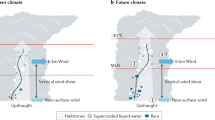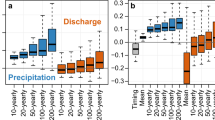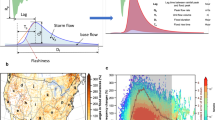Abstract
The effect of a warming climate on hailstorm frequency and intensity is largely unknown. Global climate models have too coarse resolution to simulate hailstorms explicitly; thus it is unclear if a warmer climate will change hailstorm frequency and intensity, and if so, whether such events will become more likely through intensified thunderstorms or less likely owing to overall warmer conditions. Here we investigate hail generation and maintenance for warm-season extreme precipitation events in Colorado, USA, for both present-day and projected future climates using high-resolution model simulations capable of resolving hailstorms. Most simulations indicate a near-elimination of hail at the surface in future simulations for this region, despite more intense future storms and significantly larger amounts of hail generated in-cloud. An increase in the height of the environmental melting level due to climate warming is found to be the primary reason for the disappearance of surface hail, as the warmer atmosphere increases the melting of frozen precipitation. A decrease in future surface hail at high-elevation locations may imply potential changes in both hail damage and flood risk.
This is a preview of subscription content, access via your institution
Access options
Subscribe to this journal
Receive 12 print issues and online access
$209.00 per year
only $17.42 per issue
Buy this article
- Purchase on Springer Link
- Instant access to full article PDF
Prices may be subject to local taxes which are calculated during checkout





Similar content being viewed by others
References
Doesken, N. J. Hail, hail, hail! The summertime hazard of eastern Colorado. Colorado Climate Publication 17 (Special Feature Section, 1994).
Changnon, S. A. & Changnon, D. Long-term fluctuations in hail incidences in the United States. J. Clim. 13, 658–664 (2000).
Changnon, S. A., Changnon, D. & Hilberg, S. D. Hailstorms Across the Nation: An Atlas About Hail and its Damages (Illinois State Water Survey, ISWS CR 2009-12, 2009).
McKee, T. B. & Doesken, N. J. Colorado Extreme Storm Precipitation Data Study Climatology Report 97-1 (Colorado State Univ. Dept Atmospheric Science, 1997).
Cotton, W. R., McAnelly, R. L. & Ashby, T. Development of New Methodologies for Determining Extreme Rainfall: Final Report for Contract ENC #C154213–State of Colorado (Dept Natural Resources, Dept Atmospheric Science, Colorado State Univ. 2003).
Jarrett, R. D. in What We Have Learned Since the Big Thompson Flood Vol. 16 (ed. Gruntfest, E. C.) 203–212 (Natural Hazards Research and Applications Information Center, Special Publication, 1987).
Jarrett, R. D. Paleohydrology techniques used to define the spatial occurrence of floods. Geomorphology 3, 181–195 (1990).
Jarrett, R. D. Kuo, C.Y. (ed.) in Engineering Hydrology-Proceedings of the Symposium Sponsored by the Hydraulics Division, July 25–30, 1993, San Francisco, CA 180–185 (ASCE, 1993).
Grimm, M. M., Wohl, E. E. & Jarrett, R. D. Coarse-sediment distribution as evidence of an elevation limit for flash flooding, Bear Creek, Colorado. Geomorphology 14, 199–210 (1995).
Jarrett, R. D. & Tomlinson, E. M. Regional interdisciplinary paleoflood approach to assess extreme flood potential. Water Resour. Res. 36, 2957–2984 (2000).
Hansen, E. M., Fenn, D. D., Schreiner, L. C., Stodt, R. W. & Miller, J. F. Probable Maximum Precipitation Estimates-United States between the Continental Divide and the 103rd Meridian Hydrometeorological Report No. 55A (National Weather Service, National Oceanic and Atmospheric Administration, US Department of Commerce, 1988).
Rasmussen, R. M. & Heymsfield, A. J. Melting and shedding of graupel and hail: Part I. Model physics. J. Atmos. Sci. 44, 2754–2763 (1987).
Cifelli, R. et al. A new dual-polarization radar rainfall algorithm: Application in Colorado precipitation events.. J. Atmos. Oceanic. Technol. 28, 352–364 (2011).
Willis, P. T. & Heymsfield, A. J. Structure of the melting layer in mesoscale convective system stratiform precipitation. J. Atmos. Sci. 46, 2008–2025 (1989).
Phillips, V. T. J., Pokrovsky, A. & Khain, A. The influence of time-dependent melting on the dynamics and precipitation production in maritime and continental storm clouds. J. Atmos. Sci. 64, 338–359 (2007).
Gilmore, M. S., Straka, J. M. & Rasmussen, E. N. Precipitation uncertainty due to variations in precipitation particle parameters within a simple microphysics scheme. Mon. Weather Rev. 132, 2610–2627 (2004).
Morrison, H. et al. WMO international cloud modeling workshop. Bull. Am. Meteorol. Soc. 90, 1683–1686 (2009).
Morrison, H. & Milbrandt, J. Comparison of two-moment bulk microphysics schemes in idealized supercell thunderstorm simulations. Mon. Weather Rev. 139, 1103–1130 (2011).
Niall, S. & Walsh, K. The impact of climate change on hailstorms in southeastern Australia. Int. J. Climatol. 25, 1933–1952 (2005).
Dessens, J. Severe convective weather in the context of nighttime global warming. Geophys. Res. Lett. 22, 1241–1244 (1995).
Willemse, S. A Statistical Analysis and Climatological Interpretation of Hailstorms in Switzerland Ph.D. thesis, Swiss Federal Institute of Technology, Doctor of Natural Science thesis dissertation No. 11137 (1995).
McMaster, H. The potential impact of global warming on hailstorm losses to winter cereal crops in NSW. Climatic Change 43, 455–479 (1999).
Xie, B., Zhang, Q. & Wang, Y. Trends in hail in China during 1960–2005. Geophys. Res. Lett. 35, L13801 (2008).
Mearns, L. O. et al. A regional climate change assessment program for North America. Eos 90, 311–312 (2009).
Skamarock, W. C. et al. A Description of the Advanced Research WRF Version 2 NCAR Tech. Note NCAR/TN-475+STR (2007).
Barnett, D. N., Brown, S. J., Murphy, J. M., Sexton, D. M. H. & Webb, M. J. Quantifying uncertainty in changes in extreme event frequency in response to doubled CO2 using a large ensemble of GCM simulations. Clim. Dynam. 26 (2006).
Marsh, P. T., Brooks, H. E. & Karoly, D. J. Preliminary investigation into the severe thunderstorm environment of Europe simulated by the Community Climate System Model 3. Atmos. Res. 93, 607–618 (2009).
Van Klooster, S. L. & Roebber, P. J. Surface-based convective potential in the contiguous United States in a business-as-usual future climate. J. Clim. 22, 3317–3330 (2009).
Xie, B. & Zhang, Q. Observed characteristics of hail size in four regions in China during 1980–2005. J. Clim. 23, 4973–4982 (2010).
Downton, M., Cullen, H., Morss, R., Wilhelmi, O. & Rajagopalan, B. Proc. 17th Conference on Hydrology, AMS Annual Meeting, Long Beach, CA (American Meteorological Society, 2003).
Mearns, L. O. et al. The North American Regional Climate Change Assessment Program dataset (National Center for Atmospheric Research Earth System Grid data portal, 2007); data downloaded from http://www.earthsystemgrid.org/browse/viewProject.htm?projectId=ff3949c8-2008-45c8-8e27-5834f54be50f.
Acknowledgements
This research was supported by the Postdocs Applying Climate Expertise (PACE) Fellowship Program, administered by the University Corporation for Atmospheric Research, jointly funded by the National Oceanic and Atmospheric Administration (NOAA), the Bureau of Reclamation, and the Western Water Assessment. We acknowledge NCAR and the National Science Foundation (NSF) for the availability of the WRF model and NCL software, and Unidata for the IDV package. We also wish to thank the NARCCAP project for providing the RCM data used in this paper. NARCCAP is funded by the NSF, the US Department of Energy (DoE), NOAA, and the US Environmental Protection Agency Office of Research and Development (EPA). Gratitude is extended to NOAA ESRL’s Jet Supercomputing system for providing computer resources for this work.
Author information
Authors and Affiliations
Contributions
K.M. carried out the model simulations and led the writing of the paper. M.A.A. provided project planning and leadership, as well as climate modelling expertise. G.T. contributed updated model microphysics code and provided microphysics parameterization counsel. J.J.B. provided project planning and counsel, and J.D.S. provided model initial condition files to be used for the high-resolution simulations, as well as reanalysis-based analyses, model validation, and graphics support. All contributed to editing the paper.
Corresponding author
Ethics declarations
Competing interests
The authors declare no competing financial interests.
Supplementary information
Rights and permissions
About this article
Cite this article
Mahoney, K., Alexander, M., Thompson, G. et al. Changes in hail and flood risk in high-resolution simulations over Colorado's mountains. Nature Clim Change 2, 125–131 (2012). https://doi.org/10.1038/nclimate1344
Received:
Accepted:
Published:
Issue Date:
DOI: https://doi.org/10.1038/nclimate1344
This article is cited by
-
Climate change, hailstorm incidence, and livelihood security: a perspective from Kashmir valley India
Natural Hazards (2024)
-
Changes in hail hazard across Australia: 1979–2021
npj Climate and Atmospheric Science (2023)
-
Convection-permitting modeling strategies for simulating extreme rainfall events over Southeastern South America
Climate Dynamics (2022)
-
Management of hailstorms under a changing climate in agriculture: a review
Environmental Chemistry Letters (2022)
-
The effects of climate change on hailstorms
Nature Reviews Earth & Environment (2021)



